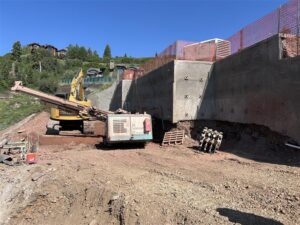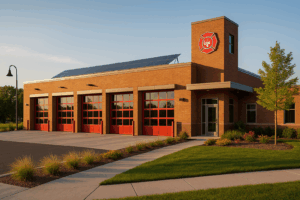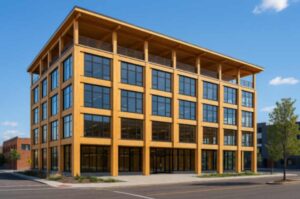Common Discrepancies in the IBC
The IBC aims to ensure safety, accessibility, and sustainability in building design. However, its broad scope and detailed provisions can lead to discrepancies. Common areas of disagreement include:
- Egress Requirements:
- Interpretations of exit routes and emergency exits can vary. You would think this would be very clear, but with so many different applications of the code language and many alternative ways to apply the metrics, there is always debate and discussion on this, which can have monumental impacts to the design of the building and associated construction costs.
- Fire Protection:
- Differences in applying fire-resistant materials and systems. Particularly when it comes to rated continuity through horizontal and vertical systems, where the IBC is largely ambiguous and often supporting information from other testing agencies or stamping professionals is required to “make a case” to a building department that may or may not be accepted.
- Accessibility:
- Varied interpretations of ADA (Americans with Disabilities Act) requirements. Add to that references in the IBC to ANSI standards, which are well known to conflict with other ADA standards. In essence, in order to meet one code, you must violate the other. And as of yet, there is no safe harbor for Owners to ensure they have met a standard of care.
The Role of Building Departments and Inspectors
Building departments, plans examiners, and inspectors interpret the IBC daily. They review plans, conduct inspections, and ensure compliance. However, their interpretations often differ based on experience and local amendments to the IBC. And if you want to argue that a particular design component should be compliant because it has been approved on a past project in another jurisdiction, or even the same jurisdiction, forget about it. The “precedence” argument generally doesn’t apply here.
Example:
- A plans examiner may interpret a fire protection code more strictly than another, leading to revisions and delays. Add to that a Fire Chief, who also has jurisdictional authority, may be more strict or more lenient and offer alternative trade-offs. This is never a predictable process and every project is unique in the eyes of the jurisdiction.
Navigating the Building Code Compliance Process
To quickly reach a decision, it’s essential to understand the review and inspection process:
- Early Consultation:
- Engage with building officials and related agencies early to clarify requirements and expectations.
- Detailed Documentation:
- Provide comprehensive and clear plans to reduce ambiguities. Provide supporting documentation to validate your case in the plans themselves.
- Professional Guidance:
- Seek assistance from experienced architectural and engineering teams. We have tremendous experience navigating this process and can apply that experience and know how to articulate the technical language with plans examiners and inspectors. We also have resources, from direct contact to the ICC to a wide network of other professionals that regularly weigh in on these issues.
How Architectural and Engineering Teams Help
Experienced teams can influence code interpretations beneficially. They understand the nuances of the IBC and can advocate effectively for the owner’s interests without compromising the health, safety and welfare of the project in any way.
Steps an Experienced Team Takes:
- Code Analysis:
- Conduct a thorough review of the IBC and all other regulatory requirements relevant to the project in every design phase. This avoids painful surprises when you make the permit submittal.
- Strategic Planning:
- Develop design strategies that meet or exceed code requirements. This can involve extensive research and often the inclusion of third party specialty consultants to build a strong case.
- Communication:
- Maintain open communication with building officials to negotiate and clarify interpretations. Pre-application meetings are strongly advised – especially if you are proposing any design solutions that are not “industry standard” or trying to innovate in any way.
Examples of Beneficial Interpretations
- Egress Flexibility:
- An architectural team proposes an alternative egress route eliminating an entire stairway that meets safety standards and gains approval through clear and concise explanation of the route and how it addresses the requirements of Section 1003.
- HVAC Systems:
- An engineering team demonstrates an innovative lower cost HVAC system with data directly from the equipment suppliers, securing a favorable interpretation on meeting the IECC.
Relevant Code Regulations
Several IBC sections often require interpretation. Key references include:
- IBC Section 1003: General Means of Egress.
- IBC Section 703: Fire-Resistance Ratings and Fire Tests.
- IBC Section 1101: Accessibility General Requirements.
Conclusion
Discrepancies in the International Building Code are common but navigable. Building departments, plans examiners, and inspectors must interpret the code, often leading to different conclusions. Early consultation, detailed documentation, and professional guidance are crucial for a smooth process. This approach not only saves time but also ensures that building projects meet safety and regulatory standards. Experienced architectural and engineering teams play a vital role in influencing interpretations and ensuring building code compliance. By understanding the IBC and all other related regulatory requirements, and working collaboratively, stakeholders can achieve compliance efficiently and effectively. For more information on navigating the IBC and ensuring compliance, consult with experienced professionals and refer to relevant IBC sections. Reach out to our team of experts at EVstudio and we can help you navigate this ever changing and ambiguous process for your next project.











